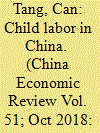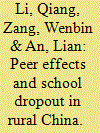| Srl | Item |
| 1 |
ID:
161878


|
|
|
|
|
| Summary/Abstract |
We present the first systematic study on child labor in China. Child labor is not a negligible social phenomenon in China; about 7.74% of children aged from 10 to 15 were working in 2010, and they worked for 6.75 h per day on average, and spent 6.42 h less per day on study than other children. About 90% of child laborers were still in school and combined economic activity with schooling. Our results show that child labor participation is positively associated with school dropout rate. A child living in a rural area is more likely to work. Compared with place of residence, the gender of a child are less important. The educational level of the household head and its interaction with the gender of the household head seem to be unimportant. However, household assets per capita and household involvement in non-agricultural activities are negatively related to the incidence of child labor. A child from a household with more adults is less likely to work. The prevalence of child labor in China exhibits significant regional variations. The child labor incidence is correlated with the development level of each region: the Western region has the highest percentage of child labor, followed by the Eastern and Central regions.
|
|
|
|
|
|
|
|
|
|
|
|
|
|
|
|
| 2 |
ID:
145748


|
|
|
|
|
| Summary/Abstract |
Students in rural China are dropping out of secondary school at troubling rates. While there is considerable quantitative research on this issue, no systematic effort has been made to assess the deeper reasons behind student decision making through a mixed-methods approach. This article seeks to explore the prevalence, correlates and potential reasons for rural dropout throughout the secondary education process. It brings together results from eight large-scale survey studies covering 24,931 rural secondary students across four provinces, as well as analysis of extensive interviews with 52 students from these same study sites. The results show that the cumulative dropout rate across all windows of secondary education may be as high as 63 per cent. Dropping out is significantly correlated with low academic performance, high opportunity cost, low socio-economic status and poor mental health. A model is developed to suggest that rural dropout is primarily driven by two mechanisms: rational cost-benefit analysis or impulsive, stress-induced decision making.
|
|
|
|
|
|
|
|
|
|
|
|
|
|
|
|
| 3 |
ID:
188937


|
|
|
|
|
| Summary/Abstract |
This study was a quasi experiment involving 470 school children who were survivors of abduction in Northern Nigeria. There were two interventions: the first was a face-to-face counselling, while the second was a visual multimedia counselling intervention. The result of the study showed that at baseline, all the respondents reported high school dropout propensity. However, after the treatment, respondents in the visual multimedia group reported lower school dropout propensity when compared to their counterparts in the face-to-face counselling. The researchers made recommendations based on the results of the study.
|
|
|
|
|
|
|
|
|
|
|
|
|
|
|
|
| 4 |
ID:
124559


|
|
|
|
|
| Publication |
2013.
|
| Summary/Abstract |
This paper attempts to identify neighborhood peer effects on children's dropout decision in rural China using the China Health and Nutrition Survey data (CHNS). Identifying peer effect is complicated by several endogenity problems including "self-selection" problem, "reflective" problem and uncontrolled "correlated effect". By taking advantage of the special feature of "Hukou" system and "son preference" phenomenon in rural China, the endogenity issues are quite reasonably addressed. More specifically, we discover a new and valid instrumental variable for peer's dropout rate: peers' firstborn boy rate. Intuitively, the more the firstborn boy peers, the lower the peers' dropout rate because of son preference and the lower one's own dropout probability due to peer effect. It is found that as peers' dropout rates increase by one percentage point, the child dropout rate would increase by 0.393 to 0.504 percentage points, the corresponding social multiplier effects of peer dropout are from 1.647 to 2.016. It is also found that elder kids and females are more susceptible to peer pressure in dropout decisions. Many other interesting findings are documented.
|
|
|
|
|
|
|
|
|
|
|
|
|
|
|
|